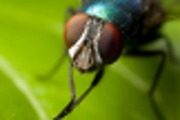There's a reason the fly swatter was invented. Flies are pesky and annoying. Bot flies are no exception but they're not your average housefly. They look and buzz like a plain old housefly but bot flies are myiatic flies. That means they invade the living tissue and organs of humans and animals and burrow into the skin when they are in their larvae stage. When they're adults, species like the Horse Stomach bot fly look like honeybees.
Know Where They Live
Most bot flies live in Central and South America, but some species, like the Horse Stomach bot fly, can be found all over the world.
This is Gross
The Human bot fly infests humans and a wide ranch of animals, especially cattle. Infections from myiatic flies start out as itchy sores and turn into painful boil-like sores that often ooze. Because the bot fly tunnels into the flesh, it has to be surgically removed.
The red larvae of the Horse Stomach bot fly develop by clustering in an animal's stomach. It can remain attached to the flesh with its mouth for up to a year.
Life Cycle
Pregnant Horse Stomach bot flies usually leave their eggs on the hairs of the forelegs and chest area of an animal. The eggs usually hatch within a week.
In the case of the Human bot fly, the female fly captures another blood-sucking insect like a tick or a mosquito and glues her eggs to its abdomen. When this insect feeds, the larvae hatch and penetrate the skin of the animal their host is sucking blood out of. They will live there until they are removed.
Did you know that not all flies fly? The 'sheep ked' is a fly that spends its entire life in the fleece of sheep.

































